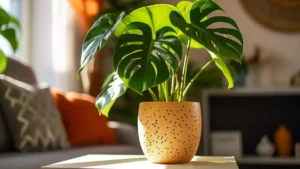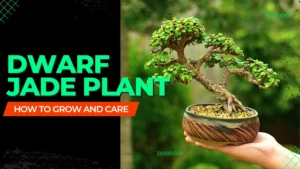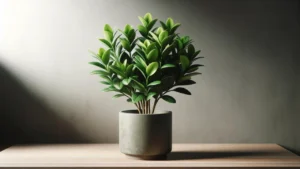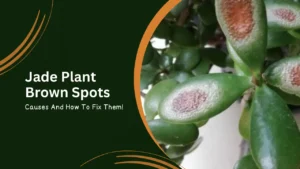No one likes pests! Jade plants typically attack a number of insects, diseases, and fungi, but gnats can be difficult to detect. Like mealybugs and spider mites, they feed on the roots of succulents and live in the soil.
If you spot gnats around your plant, check the soil first: it may just save your jade plant. If you don’t do this, they will lay eggs in moist soil and cause problems.
Gnats are a problem for jade plant growers and gardeners. However, the good news is getting rid of gnats and preventing their return is simple.
Using this guide, you will be able to prevent and treat infestations of fungus gnats.
Table of Contents
What Are Fungus Gnats
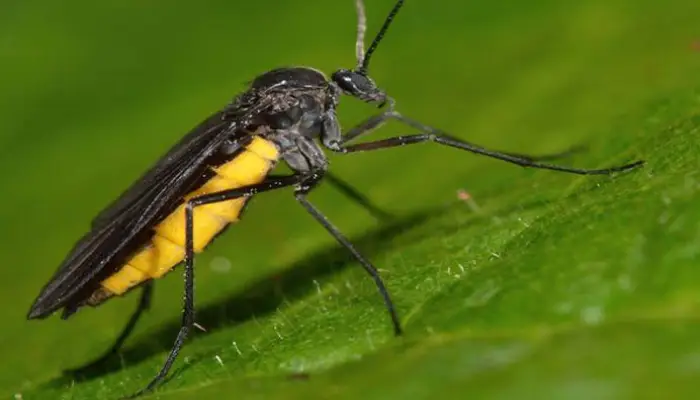
A fungus gnat is a small, black fly that lives primarily in soil.
Many people mistake fungus gnats for fruit flies. However, when you look closer you can see their more defined wings.
Also, moisture attracts the fungus gnats. So, people may find that their plants are infested after they water them.
If you notice tiny black flies in your home or office, you need to treat your jade plant for fungus gnats.
What Causes Fungus Gnats on Jade Plant
For several reasons, jade attracts gnats.
Whenever there is damp soil, fungus gnats lay their eggs in the potting mix.
So, if you overwater your jade plant and allow the soil to stay soggy, this can happen. In such an environment, your jade will rot, and gnats will take advantage of rotten plant matter to breed.
It is also possible for gnats to come in on the jade plant from outside. In case the soil wasn’t dry enough after transplanting, you may have brought gnat eggs into the pot.
Another reason why fungus gnats might be attracted to your jade plant – they love their sticky sap. If gnats fly around your plants and are stuck in the sap, they can lay their eggs there.
If you notice adult fungus gnats flying around your soil, it’s time to take action!
How To Get Rid of Fungus Gnats on Jade Plant
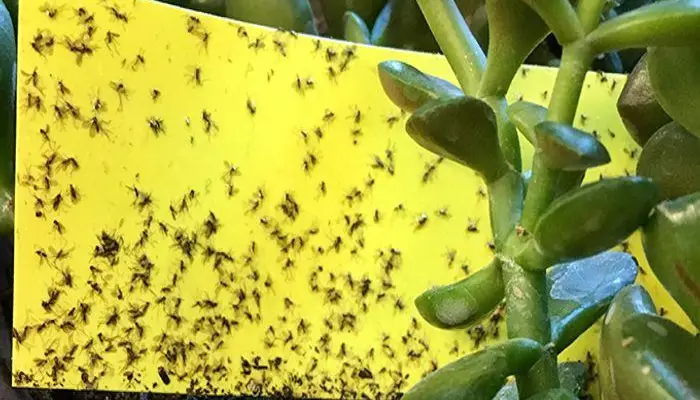
Fungal gnats are a common problem when you have jade plants at home. Also, it’s super annoying!
Gnat flies are those little things that fly around when you turn on the lights at night. It is important to act early when you notice them around your jade plant, as they can be difficult to get rid of once they infest an area.
The first step in getting rid of gnats is to identify whether they are fungus gnats or fruit flies.
Look at the wings: Fruit flies have clear or black wings, while gnats have brownish-grey wings.
The next step is to find out what triggers them to leave their tiny gnat-sized homes (usually succulent soil). Some things that can cause gnats to fly around include:
- When there is too much moisture in the air (humidity),
- When your plants don’t get enough ventilation.
- When you overwater your plant! (Sometimes, we forget our awesome responsibility to care for our jade plant because we get too busy.)
Now that you know what to look out for, let’s kill some gnats! Here are some ways to get rid of gnats:
Gnat Traps
The most effective method is to buy gnat traps, which are essentially sticky tape that gnats stick to.
Sadly, these suckers don’t discriminate between types of gnats. So, if you have both fruit flies and fungus gnats, they will all die!
Alcohol Spray
Use rubbing alcohol (at its highest concentration). Spray your plants down wherever they have been exposed to moist soil or water.
It is likely that you will see results in 24 hours, as the gnats will die from suffocation.
If you are afraid of killing the beneficial bacteria in your jade pots, don’t go overboard with the alcohol.
Just a couple of spritzes should do the trick!
Diatomaceous Earth
There’s a lot of silica in this gnat-killing powder. It will kill the gnats by drying them out.
If you want to get between all those tiny spaces where gnats like to hide, sprinkle DE on soil or take a fine brush.
Hydrogen Peroxide
If you have gnats flying around your plants like crazy, you can kill them by putting some hydrogen peroxide in the soil.
If gnats are already flying around, this method won’t be as effective. In addition, you may want to combine it with some of the other methods here.
Cinnamon Powder
A gnat’s worst enemy is cinnamon powder. In addition to killing them on contact, it smells great!
To use this gnat-killing method, sprinkle cinnamon powder wherever moist soil is present or gnats are present.
Avoid using too much at once, as your plants may have trouble absorbing the water.
Neem Oil
Besides killing off gnats, neem oil also repels other gnat species from settling in your succulent soil!
Even if you have root rot or fungus gnats, you can still use this method to get rid of the gnats.
Dish Soap
This gnat-killing method is pretty simple: mix dish soap with water (the cheaper, the better).
Don’t worry about diluting too much, gnats can handle a little harshness! Make sure to spray this mixture wherever there is moist soil or gnats.
Why is my Jade Plant Attracting Gnats?
It is for a variety of reasons that jade plants attract bugs and gnats.
It may be due to the growing environment or improper care that your plant has gnats.
Moreover, there are fungus gnats that eat succulent plants.
When these larvae infest the soil, they lay their eggs so they can grow up to be gnatty adults. This is because damp soil is ideal for feeding and breeding since fungus thrives there.
Also, sugary sap attracts fungus gnats. And jade plants release a nectar-like substance that protects ants from other insects.
Gnats love these sweet secretions so much that they will lay eggs on your plants. It may be the sweet nectar of your plant that attracts gnats, but bright lights at night will also attract them. So turn off nearby lighting if you want to get rid of them permanently.
It is also possible for fungus gnats to live outdoors as well. So if gnats are breeding in your succulent garden, you may need to deal with gnat infestations.
How To Identify Fungus Gnats on Jade Plant
An easy way to identify fungus gnats is to look at their wings. They are small gnat-like insects.
Unlike other gnats, they have long legs and a large abdomen, so they can fly long distances.
In addition to black or brown, fungus gnats can also be tan in color.
At all times of the year, especially in the winter, fungus gnats love moisture and humidity.
As succulents naturally trap water inside themselves, they require little water, so they are ideal breeding grounds for fungus gnats.
Having yellowish, distorted leaves on jade plants is an indication that you have fungus gnats. This may indicate fungus gnats have eaten them, but it does not necessarily mean they are present.
Also, it is not possible to tell what type of pest is attacking your succulents without looking for other signs. For example, signs like larvae or adults.
The Life Cycle Of Fungus Gnats On the Jade Plant: How To Identify Adults, Larvae, And Eggs
In the gnat life cycle, adults reach adulthood in two weeks.
Typically, the female gnats lay 20 to 40 eggs at a time on the soil of their succulent pots or in cracks.
If you see these succulent pests outside, make sure you check every inch of your house for them!
In just one day, the larvae hatch from their egg casings. Moreover, they eat their way through any plant material around them until they pupate into adults and fly away.
The fungus gnat does not live longer than two weeks before dying, but it takes them a long time to mature.
In about a month after the gnats lay their eggs, their larvae hatch and begin eating your plant. After pupating, gnats live just two weeks before laying eggs again!
How To Prevent Fungus Gnats on Jade Plants
For succulent owners, fungus gnats are a common problem. Although they can be extremely irritating, it’s easy to prevent them!
Ensure you do not overwater your soil mix if it is poorly draining.
In order to keep your jade plant from getting too wet, make sure the soil is never too moist.
After watering your plant, ensure that water doesn’t accumulate on top of the soil. Hence, use soil with excellent drainage.
In addition, you may want to avoid watering succulents from above. Because gnats are attracted to water droplets that form on leaves.
Make sure the soil mix you use is well draining so that you do not overwater your succulents. Also, before watering again, let the top of the soil mix dry out.
Maintain fresh soil by repotting regularly
From time to time, it’s helpful to replace the old or bad soil with fresh organic quality soil.
In this way, you can prevent fungus gnat infestations. Also, it removes potential breeding grounds for gnats within old pots that have been too wet for a long time.
If you are repotting your plant, always use fresh potting soil with perlite or sand.
Keep your plant clean by removing all debris
It is also essential to clean up all debris around your plant. A gnat likes to lay its eggs in dead plant matter. So, make sure all of the gnats’ breeding grounds are removed.
Keep your plant free of debris by removing dead leaves, flowers, and stems regularly.
Regularly removing all debris and dead matter around your jade plant will keep gnats at bay.
Don’t let your jade plant sit in wet areas
Keep your jade plant out of regularly wet places to prevent gnats from breeding.
If you are growing plants near a sink or shower, you might want to avoid growing them there.
In any case, avoid keeping them near drains or other wet areas.
Also, ensure your jade plants are not placed in humid or high-moisture areas where gnat larvae breed.
If you are plagued by gnats, placing your plant in a location with lower humidity may help.
Immediately remove gnat-infested plant
As gnats are able to fly and spread quickly, you will need to remove gnat-infested plants from your collection.
For plants with fungus gnat problems, removing the affected plant is critical.
It is crucial to remove succulents that are infested with gnats right away. In case you already have gnat infestations in your home, removing the affected plants might help keep them from spreading.
Conclusion
It is common for the jade plant to be infested with fungus gnats. If you know the cause and how to deal with gnats on a jade plant, the problem can be easily resolved.
If you notice gnats around your plant, act fast before they cause any damage or reproduce.
Since gnats like moist soil, it’s important to let the soil dry out and remove any standing water.
A key part of preventing gnats from returning is removing their food sources.
The most important thing to remember is that prevention is always better than cure.
Before placing a new succulent in your home, inspect it for gnats and larvae.
If you do this, you won’t have any issues down the road because you can get rid of them right away.
If you have any questions about gnats on jade plants, please post them in the comment section.
FAQs
Q1. What is the reason for the gnats around my jade plant?
Fungus gnats on a jade plant mean two things. You are providing way too much water, and your plants are in the wrong soil. Well-drained, gravelly soil is ideal for a jade plant.
Q2. How do you get rid of fungus gnats in potting soil?
To eliminate your fungus gnat infestation, install sticky traps, and top-dress the soil with sand. Also, you can do nematode soaks every 10 to 14 days until the problem is resolved. Moreover, stop overwatering your plants and remove any unnecessary sources of moisture.
Q3. Why does my indoor plant have gnats?
Fruit flies and gnats are comfortable in damp dirt. Their eggs and larvae cannot survive without constant moist conditions. Try testing the soil with your finger. And only watering when it’s completely dry at least 2 inches below the surface. Most plants can handle less water than you are giving them, so don’t overwater them.
Q4. What to spray on plants to get rid of gnats?
1. With two liters of water, mix one tablespoon of lemon-scented dish soap.
2. Apply the soap mixture liberally to the infested houseplant.
3. After one to two hours, spray the plant with plain water to rinse off the soap.
Q5. Does vinegar get rid of gnats in houseplants?
You can kill adult fungus gnats with organic traps. Add liquid dish soap to apple cider vinegar or red wine in the bottom of a deep bowl. Place it near your infested house plants. This attraction leads to the gnats falling into it and dying.
Q6. What is the best gnat Killer?
Make a trap with apple cider vinegar. Add warm water, 2 tablespoons of apple cider vinegar, 1 tablespoon sugar, and 6 drops of liquid dish soap. The sugary mixture will attract gnats, but once they dip in for a drink, the sticky dish soap will trap them.
Q7. Where do gnats lay eggs?
Egg laying sites include dirty drain lines, poorly cleaned garbage disposals and garbage cans, and recycle containers. Or any place where “organic slime” accumulates.
Q8. Do gnats go away on their own?
No, gnats won’t disappear on their own once they start reproducing. Get rid of them by putting away your fruit, flushing out your drains, or changing the soil in your indoor plants.
Q9. How long does it take for gnats to go away?
Adult fungus gnats can live for one to two weeks and complete one life cycle in 18-30 days.
Q10. Should I re-pot my plant if it has fungus gnats?
A fungus gnat can spread from one plant to another fairly quickly, so take precautions. Consider repotting the plant if the infestation isn’t too bad. Using your fingers or a small brush, gently remove as much soil as possible from around the roots of the plant.











